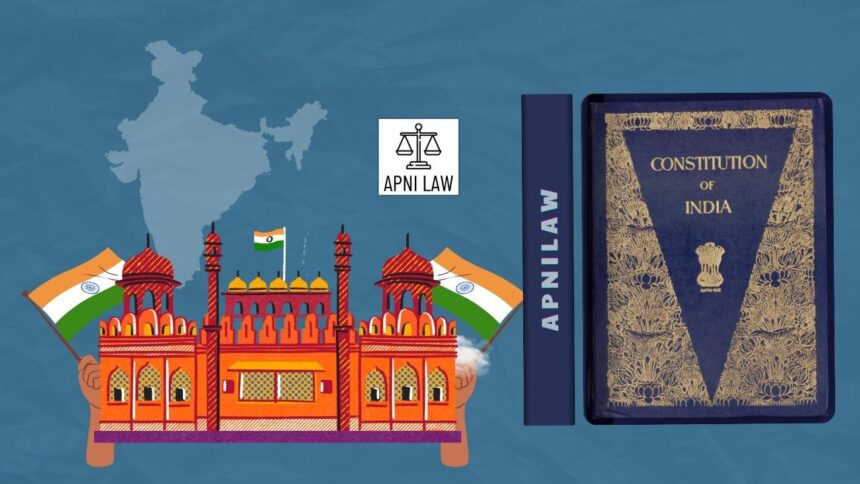The Indian Constitution incorporates several federal features that distribute power between the Union and the states. These provisions aim to maintain national unity while allowing regional diversity. India did not adopt a purely federal system like the United States, but it also did not embrace a fully unitary framework like the United Kingdom. Instead, India created a unique federal structure that balances central authority with state autonomy. This model reflects the country’s vast size, diverse culture, and complex political history.
How Does the Dual Government Polity Work?
India’s Constitution establishes a dual polity. This means that there are two levels of government, the Union government at the center and the state governments in the regions. Each government functions independently within its own domain. The Union deals with matters of national importance such as defense, foreign policy, and monetary issues. The states focus on local concerns such as public health, law and order, and agriculture. This arrangement ensures that governance operates at both the national and regional levels, addressing the needs of a diverse population.
The framers of the Constitution deliberately adopted this dual structure. They recognized that a single centralized government could not effectively manage a country as large and diverse as India. By creating two levels of government, they enabled power to be shared in a way that maintains unity while respecting diversity.
How Is Power Divided Between Centre and States?
The division of powers is one of the core federal features. The Constitution uses the Seventh Schedule to distribute legislative subjects into three lists. The Union List gives the central government authority over areas of national significance, including defense, foreign affairs, and atomic energy. The State List assigns control over subjects such as police, public health, and agriculture to the states. The Concurrent List includes areas like education, forests, and marriage, where both the Union and the states can legislate.
In case of conflict between central and state laws on a concurrent subject, the central law prevails. This rule strengthens the authority of Parliament but still allows states to legislate on important social and economic matters. This structure avoids duplication and confusion by clearly outlining jurisdiction.
Why Is a Written Constitution Important for Federalism?
A written constitution is essential in a federal system because it defines the relationship between the Union and the states. India’s Constitution is the lengthiest in the world, and it carefully outlines the distribution of powers, the functioning of institutions, and the role of different levels of government. Because the Constitution is codified, it reduces ambiguity and provides a framework for resolving disputes.
The existence of a written document also ensures stability. States cannot question the distribution of power because it is clearly specified. The Constitution serves as a reference point whenever disagreements arise, which strengthens federal governance.
What Role Does the Supremacy of the Constitution Play?
The Indian Constitution is the supreme law of the land. Both the Union Parliament and the State Legislatures must work within its framework. If any law contradicts the Constitution, courts can strike it down as invalid. This supremacy prevents arbitrary action by either the center or the states.
The principle of supremacy ensures that all institutions operate under a common framework. It also protects the basic structure of the Constitution, which cannot be amended even by Parliament. This strengthens democracy and preserves the balance of power in a federal framework.
How Does the Judiciary Safeguard Federalism?
The judiciary plays a vital role in protecting India’s federal character. The Supreme Court functions as the guardian of the Constitution. It interprets provisions, resolves disputes between the Union and the states, and protects fundamental rights. When conflicts arise over the division of powers, the judiciary acts as an impartial referee.
For example, when a state challenges the authority of Parliament to legislate on a particular subject, the Supreme Court decides the matter based on constitutional provisions. By exercising judicial review, the judiciary ensures that neither the Union nor the states exceed their constitutional limits. This maintains equilibrium in the federal system.
Why Does the Constitution’s Rigidity Support Federalism?
Federal systems require stability. The Indian Constitution achieves this by making federal provisions relatively rigid. Amending provisions that affect the balance of power between the Union and the states requires a special majority in Parliament. Additionally, at least half of the state legislatures must ratify the amendment.
This process ensures that the Union cannot unilaterally alter the federal arrangement. States play a direct role in approving changes, which strengthens their position within the federation. Rigidity thus protects the distribution of powers and prevents frequent shifts that could destabilize governance.
How Does Bicameralism Enhance Federalism?
India’s Parliament is bicameral. The Lok Sabha represents the people directly, while the Rajya Sabha represents the states. This structure ensures that regional concerns are considered in national decision-making. The Rajya Sabha, as the Council of States, allows states to participate in shaping central laws and policies.
Although the Rajya Sabha is not as powerful as the US Senate, it still provides a platform for regional voices. This bicameral system strengthens the federal framework by balancing the interests of both the Union and the states.
What Additional Features Strengthen Federalism?
India’s federalism extends beyond the traditional Union-state relationship. The Constitution provides for single citizenship, which fosters national unity. Unlike countries such as the US, where citizens hold both state and federal citizenship, India grants a single legal identity. This ensures equality across the nation.
Local self-government also strengthens federalism. The 73rd and 74th Constitutional Amendments created Panchayats and Municipalities as autonomous institutions at the grassroots level. This brings governance closer to the people and decentralizes power further.
Asymmetrical federalism is another unique feature. Some states and regions enjoy special provisions under Articles 370 and 371. These articles recognize India’s diversity by granting different levels of autonomy to certain regions. While Article 370 for Jammu and Kashmir was abrogated in 2019, other provisions for northeastern states and hill regions remain in force. This asymmetry allows flexibility in governance without undermining national unity.
How Does Federalism Balance Unity and Diversity in India?
Federal features in the Indian Constitution reflect the need to balance unity with diversity. The Union government maintains a strong role to safeguard national security, economic integration, and foreign policy. At the same time, states enjoy autonomy in managing regional affairs. This arrangement prevents excessive centralization while avoiding the instability of a loose confederation.
The framers of the Constitution understood that India’s vast cultural and linguistic diversity required regional autonomy. Yet they also recognized the risks of fragmentation. The federal structure they designed reflects this delicate balance.
Why Is the Indian Model Called Quasi-Federal?
Many scholars describe India’s system as “quasi-federal.” This means that while India has federal features, the Union remains stronger than the states. The Union List contains more subjects than the State List, and in emergencies, Parliament can assume full control. The Union also holds residuary powers, unlike in the United States, where residuary powers rest with the states.
This central tilt reflects historical circumstances. After independence, India faced challenges of integration, linguistic diversity, and external threats. A strong center was necessary to maintain unity. At the same time, the Constitution incorporated federal features to respect state autonomy.
For any specific query call at +91 – 8569843472
Conclusion
The federal features of the Indian Constitution highlight its balanced approach to governance. By creating a dual polity, dividing powers, establishing a written constitution, ensuring supremacy, empowering the judiciary, and protecting rigidity, India safeguards both unity and diversity. Additional elements like bicameralism, local self-government, and asymmetrical provisions strengthen this federal framework.
India’s model is not purely federal nor purely unitary. It is a unique blend that addresses the needs of a diverse society while ensuring national integration. This federal structure continues to evolve, but its core features remain central to India’s democratic stability.







